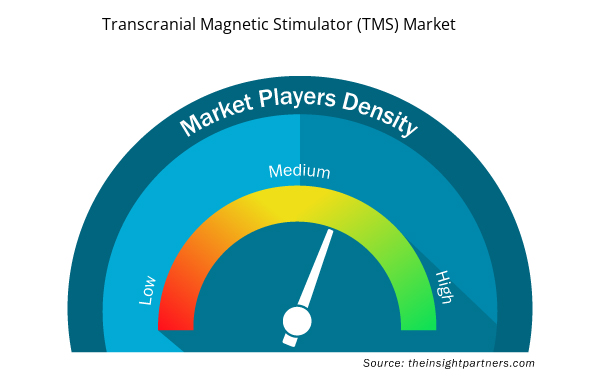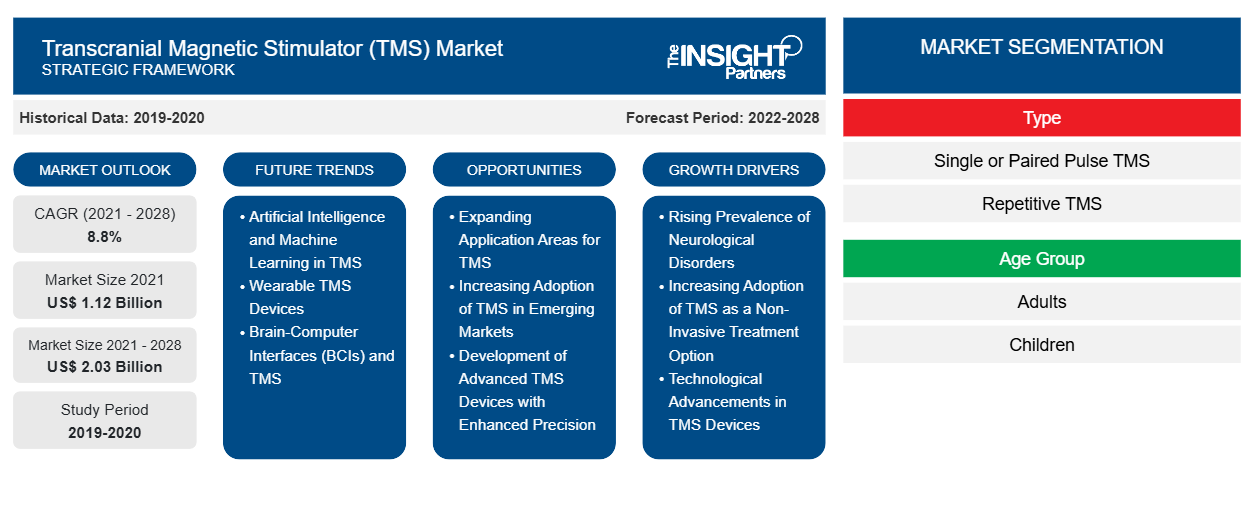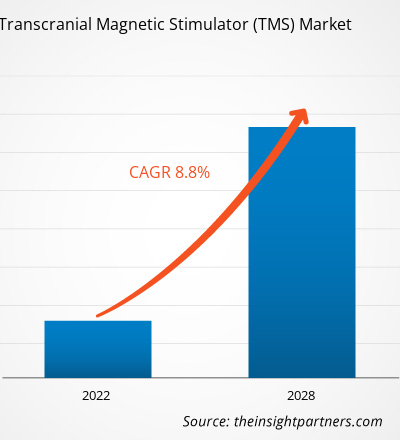[Rapport de recherche] Le marché des stimulateurs magnétiques transcrâniens (TMS) devrait atteindre 2 029,71 millions USD d'ici 2028, contre 1 122,22 millions USD en 2021 ; il devrait enregistrer un TCAC de 8,8 % de 2021 à 2028.
Les troubles neurologiques affectent le cerveau et les nerfs du corps humain et provoquent entre autres l'épilepsie et les crises d'épilepsie, la maladie de Parkinson, la démence, l'autisme, la maladie d'Alzheimer, les tumeurs cérébrales et la paralysie cérébrale. La prévalence des troubles neurologiques augmente dans le monde entier. Selon l'étude Global Burden of Disease (GBD) 2017, la maladie d'Alzheimer et d'autres démences [2,55 millions d'années de vie corrigées de l'incapacité (DALY)], les accidents vasculaires cérébraux [environ 3,58 millions d'DALY] et la migraine (environ 2,40 millions d'DALY) étaient les trois maladies neurologiques les plus lourdes aux États-Unis en termes de nombre total d'années de vie corrigées de l'incapacité.
En outre, l'Alzheimer's Association estime que plus de 6 millions d'Américains souffrent de la maladie d'Alzheimer, et ce nombre devrait atteindre près de 13 millions d'ici 2050. Le stimulateur magnétique transcrânien (TMS) est largement utilisé pour le diagnostic et le traitement des troubles neurologiques. Par exemple, selon BrainsWay Ltd., en avril 2021, 100 000 patients à travers le monde ont été traités avec son Deep TMS. Ainsi, la prévalence croissante des troubles neurologiques stimule la croissance du marché mondial des stimulateurs magnétiques transcrâniens (TMS) . De plus, la dépression est l'un des troubles mentaux observés couramment chez les personnes du monde entier. Selon les données publiées par l'OMS en janvier 2020, plus de 264 millions de personnes de tous âges souffrent de dépression dans le monde.
Personnalisez ce rapport en fonction de vos besoins
Vous bénéficierez d'une personnalisation gratuite de n'importe quel rapport, y compris de certaines parties de ce rapport, d'une analyse au niveau des pays, d'un pack de données Excel, ainsi que de superbes offres et réductions pour les start-ups et les universités.
- Obtenez les principales tendances clés du marché de ce rapport.Cet échantillon GRATUIT comprendra une analyse de données, allant des tendances du marché aux estimations et prévisions.
Informations sur le marché
La stimulation magnétique transcrânienne (TMS) est une procédure non invasive qui aide à traiter les troubles neurologiques. De plus, les développements technologiques croissants dans le domaine de la TMS ont accru ses applications. Les entreprises opérant sur le marché des stimulateurs magnétiques transcrâniens (TMS) adoptent diverses stratégies telles que l'obtention d'approbations de la Food and Drug Administration (FDA) pour leurs produits innovants, des partenariats commerciaux et la levée de fonds pour le développement de produits, qui propulsent la croissance du marché.
Voici quelques exemples de développements :
- En mars 2021, MagVenture a présenté le MagVenture Flow Arm, un système de positionnement clinique en instance de brevet, conçu pour optimiser la mise en œuvre des protocoles approuvés par la FDA de MagVenture pour la technologie de stimulation cérébrale non invasive pour le traitement du trouble dépressif majeur et comme thérapie d'appoint pour le trouble obsessionnel compulsif (TOC).
- En août 2020, la thérapie TMS MagVenture a reçu l'autorisation de la FDA pour le traitement complémentaire des TOC. Il s'agit de la deuxième indication aux États-Unis pour la société danoise de dispositifs médicaux MagVenture.
- En février 2019, eNeura, Inc., une société privée de technologie médicale, a annoncé une nouvelle autorisation 510(k) de la FDA. Avec cette autorisation, la société a affirmé que le sTMS est le seul produit contre la migraine aux États-Unis pour le traitement des migraines aiguës et prophylactiques chez les adultes et les enfants (12 ans et plus).
Ainsi, l’implication active des acteurs mondiaux dans le développement de la stimulation magnétique transcrânienne et des technologies associées devrait soutenir la croissance du marché.
Informations basées sur les types
En fonction du type, le marché des stimulateurs magnétiques transcrâniens (TMS) est segmenté en TMS à impulsions simples ou appariées et en TMS répétitives (rTMS). En 2021, le segment TMS à impulsions simples ou appariées détenait une part de marché plus importante. Cependant, le segment TMS répétitif (rTMS) devrait connaître un TCAC plus élevé au cours de la période 2021-2028.
Informations basées sur les applications
En fonction des applications, le marché est segmenté en recherche, diagnostic et thérapeutique. En 2021, le segment du diagnostic détenait la plus grande part du marché et devrait connaître le TCAC le plus élevé au cours des prochaines années.
Les entreprises opérant sur le marché des stimulateurs magnétiques transcrâniens (TMS) mettent l'accent sur l'adoption de la stratégie d'innovation de produits pour répondre à l'évolution des demandes des clients à travers le monde, ce qui leur permet également de maintenir leur nom de marque sur le marché mondial.
Portée du rapport sur le marché des stimulateurs magnétiques transcrâniens
Aperçu régional du marché des stimulateurs magnétiques transcrâniens (TMS)
Les tendances et facteurs régionaux influençant le marché des stimulateurs magnétiques transcrâniens (TMS) tout au long de la période de prévision ont été expliqués en détail par les analystes d’Insight Partners. Cette section traite également des segments et de la géographie du marché des stimulateurs magnétiques transcrâniens (TMS) en Amérique du Nord, en Europe, en Asie-Pacifique, au Moyen-Orient et en Afrique, ainsi qu’en Amérique du Sud et en Amérique centrale.

- Obtenez les données régionales spécifiques au marché des stimulateurs magnétiques transcrâniens (TMS)
Portée du rapport sur le marché des stimulateurs magnétiques transcrâniens (TMS)
| Attribut de rapport | Détails |
|---|---|
| Taille du marché en 2021 | 1,12 milliard de dollars américains |
| Taille du marché d'ici 2028 | 2,03 milliards de dollars américains |
| Taux de croissance annuel moyen mondial (2021-2028) | 8,8% |
| Données historiques | 2019-2020 |
| Période de prévision | 2022-2028 |
| Segments couverts | Par type
|
| Régions et pays couverts | Amérique du Nord
|
| Leaders du marché et profils d'entreprises clés |
|
Densité des acteurs du marché : comprendre son impact sur la dynamique des entreprises
Le marché des stimulateurs magnétiques transcrâniens (TMS) connaît une croissance rapide, tirée par la demande croissante des utilisateurs finaux en raison de facteurs tels que l'évolution des préférences des consommateurs, les avancées technologiques et une plus grande sensibilisation aux avantages du produit. À mesure que la demande augmente, les entreprises élargissent leurs offres, innovent pour répondre aux besoins des consommateurs et capitalisent sur les tendances émergentes, ce qui alimente davantage la croissance du marché.
La densité des acteurs du marché fait référence à la répartition des entreprises ou des sociétés opérant sur un marché ou un secteur particulier. Elle indique le nombre de concurrents (acteurs du marché) présents sur un marché donné par rapport à sa taille ou à sa valeur marchande totale.
Les principales entreprises opérant sur le marché des stimulateurs magnétiques transcrâniens (TMS) sont :
- BrainsWay Ltée
- Nexstim
- Magstim
- Neuronétique
- Solutions Neurologiques TMS
Avis de non-responsabilité : les sociétés répertoriées ci-dessus ne sont pas classées dans un ordre particulier.

- Obtenez un aperçu des principaux acteurs du marché des stimulateurs magnétiques transcrâniens (TMS)
Marché des stimulateurs magnétiques transcrâniens (TMS) – Segmentation
Par type
- TMS à impulsions simples ou appariées
- TMS répétitif (rTMS)
Par groupe d'âge
- Adultes
- Enfants
Par application
- Recherche
- Diagnostique
- Thérapeutique
Par géographie
- Amérique du Nord
- NOUS
- Canada
- Mexique
- Europe
- France
- Allemagne
- Italie
- ROYAUME-UNI
- Espagne
- Reste de l'Europe
- Asie-Pacifique (APAC)
- Chine
- Inde
- Corée du Sud
- Japon
- Australie
- Reste de l'APAC
- Moyen-Orient et Afrique (MEA)
- Afrique du Sud
- Arabie Saoudite
- Émirats arabes unis
- Reste de la MEA
- Amérique du Sud et Amérique centrale (SCAM)
- Brésil
- Argentine
- Reste de SCAM
Profils d'entreprise
- BrainsWay Ltée
- Nexstim, Magstim
- Neuronétique
- Solutions Neurologiques TMS
- MagVenture, Inc.
- eNeura Inc.
- Neurosoft
- MAG & More GmbH
- Analyse historique (2 ans), année de base, prévision (7 ans) avec TCAC
- Analyse PEST et SWO
- Taille du marché Valeur / Volume - Mondial, Régional, Pays
- Industrie et paysage concurrentiel
- Ensemble de données Excel



Report Coverage
Revenue forecast, Company Analysis, Industry landscape, Growth factors, and Trends

Segment Covered
This text is related
to segments covered.

Regional Scope
North America, Europe, Asia Pacific, Middle East & Africa, South & Central America

Country Scope
This text is related
to country scope.
Questions fréquemment posées
Asia Pacific is expected to be the fastest-growing region and is likely to expand at a high growth rate due to large geriatric population, rising numbers of neurological disorders are among the factors expected to drive the market in the region during the forecast period.
The global Transcranial Magnetic Stimulator (TMS) market based on type is segmented into Single or paired pulse TMS and Repetitive TMS (rTMS). In 2021, the Single or paired pulse TMS segment held the largest share of the market, by type. The Repetitive TMS (rTMS) segment of Transcranial Magnetic Stimulator (TMS) market is also expected to witness fastest CAGR during 2021 to 2028..
The Transcranial Magnetic Stimulator (TMS) market majorly consists of the players such as BrainsWay Ltd, Nexstim, Magstim, Neuronetics, TMS Neuro Solutions, MagVenture, Inc., eNeura Inc., Neurosoft, MAG & More GmbH. REMED among others amongst others.
The US is the largest market for Transcranial Magnetic Stimulator (TMS) at a global level. The US is the largest and fastest-growing market for the TMS market. The market growth is attributed to increasing developments of the medical device sector for neuromodulation, significantly rising incidences of neurological disorders among people and growing demand for neuromodulation devices for chronic pain management. In addition, the economic burden to treat neurological disorders is significantly growing in the country. For instance, according to a study published by the American Neurological Association in March 2017, ~US$ 800 billion is spent per year for treating neurological disorders. The cost of treatment affects ~100 million people every year across the country. It is also estimated that the treatment cost of dementia and stroke alone is estimated to reach over US$ 600 billion in 2030.
The factors that are driving and restraining factors that will affect Transcranial Magnetic Stimulator (TMS) market in the coming years. Factors such as rising prevalence of neurological disorders, growing developments in transcranial magnetic stimulation technology are driving the market growth. However, high cost of diagnostic and treatment are likely to hamper the growth of the market.
Transcranial Magnetic Stimulator (TMS), also referred to us repetitive Transcranial Magnetic Stimulator (rTMS), is a type of brain stimulation in which a changing magnetic field is applied to a specific area of the brain. An electric pulse stimulator is attached to a magnetic coil, which is then connected to the scalp. It is a non-invasive procedure and is used for diagnostic and therapeutic applications.
Trends and growth analysis reports related to Life Sciences : READ MORE..
The List of Companies - Transcranial Magnetic Stimulator (TMS) Market
- BrainsWay Ltd
- Nexstim
- Magstim
- Neuronetics
- TMS Neuro Solutions
- MagVenture, Inc.
- eNeura Inc.
- Neurosoft
- MAG & More GmbH.
- REMED
The Insight Partners performs research in 4 major stages: Data Collection & Secondary Research, Primary Research, Data Analysis and Data Triangulation & Final Review.
- Data Collection and Secondary Research:
As a market research and consulting firm operating from a decade, we have published and advised several client across the globe. First step for any study will start with an assessment of currently available data and insights from existing reports. Further, historical and current market information is collected from Investor Presentations, Annual Reports, SEC Filings, etc., and other information related to company’s performance and market positioning are gathered from Paid Databases (Factiva, Hoovers, and Reuters) and various other publications available in public domain.
Several associations trade associates, technical forums, institutes, societies and organization are accessed to gain technical as well as market related insights through their publications such as research papers, blogs and press releases related to the studies are referred to get cues about the market. Further, white papers, journals, magazines, and other news articles published in last 3 years are scrutinized and analyzed to understand the current market trends.
- Primary Research:
The primarily interview analysis comprise of data obtained from industry participants interview and answers to survey questions gathered by in-house primary team.
For primary research, interviews are conducted with industry experts/CEOs/Marketing Managers/VPs/Subject Matter Experts from both demand and supply side to get a 360-degree view of the market. The primary team conducts several interviews based on the complexity of the markets to understand the various market trends and dynamics which makes research more credible and precise.
A typical research interview fulfils the following functions:
- Provides first-hand information on the market size, market trends, growth trends, competitive landscape, and outlook
- Validates and strengthens in-house secondary research findings
- Develops the analysis team’s expertise and market understanding
Primary research involves email interactions and telephone interviews for each market, category, segment, and sub-segment across geographies. The participants who typically take part in such a process include, but are not limited to:
- Industry participants: VPs, business development managers, market intelligence managers and national sales managers
- Outside experts: Valuation experts, research analysts and key opinion leaders specializing in the electronics and semiconductor industry.
Below is the breakup of our primary respondents by company, designation, and region:

Once we receive the confirmation from primary research sources or primary respondents, we finalize the base year market estimation and forecast the data as per the macroeconomic and microeconomic factors assessed during data collection.
- Data Analysis:
Once data is validated through both secondary as well as primary respondents, we finalize the market estimations by hypothesis formulation and factor analysis at regional and country level.
- Macro-Economic Factor Analysis:
We analyse macroeconomic indicators such the gross domestic product (GDP), increase in the demand for goods and services across industries, technological advancement, regional economic growth, governmental policies, the influence of COVID-19, PEST analysis, and other aspects. This analysis aids in setting benchmarks for various nations/regions and approximating market splits. Additionally, the general trend of the aforementioned components aid in determining the market's development possibilities.
- Country Level Data:
Various factors that are especially aligned to the country are taken into account to determine the market size for a certain area and country, including the presence of vendors, such as headquarters and offices, the country's GDP, demand patterns, and industry growth. To comprehend the market dynamics for the nation, a number of growth variables, inhibitors, application areas, and current market trends are researched. The aforementioned elements aid in determining the country's overall market's growth potential.
- Company Profile:
The “Table of Contents” is formulated by listing and analyzing more than 25 - 30 companies operating in the market ecosystem across geographies. However, we profile only 10 companies as a standard practice in our syndicate reports. These 10 companies comprise leading, emerging, and regional players. Nonetheless, our analysis is not restricted to the 10 listed companies, we also analyze other companies present in the market to develop a holistic view and understand the prevailing trends. The “Company Profiles” section in the report covers key facts, business description, products & services, financial information, SWOT analysis, and key developments. The financial information presented is extracted from the annual reports and official documents of the publicly listed companies. Upon collecting the information for the sections of respective companies, we verify them via various primary sources and then compile the data in respective company profiles. The company level information helps us in deriving the base number as well as in forecasting the market size.
- Developing Base Number:
Aggregation of sales statistics (2020-2022) and macro-economic factor, and other secondary and primary research insights are utilized to arrive at base number and related market shares for 2022. The data gaps are identified in this step and relevant market data is analyzed, collected from paid primary interviews or databases. On finalizing the base year market size, forecasts are developed on the basis of macro-economic, industry and market growth factors and company level analysis.
- Data Triangulation and Final Review:
The market findings and base year market size calculations are validated from supply as well as demand side. Demand side validations are based on macro-economic factor analysis and benchmarks for respective regions and countries. In case of supply side validations, revenues of major companies are estimated (in case not available) based on industry benchmark, approximate number of employees, product portfolio, and primary interviews revenues are gathered. Further revenue from target product/service segment is assessed to avoid overshooting of market statistics. In case of heavy deviations between supply and demand side values, all thes steps are repeated to achieve synchronization.
We follow an iterative model, wherein we share our research findings with Subject Matter Experts (SME’s) and Key Opinion Leaders (KOLs) until consensus view of the market is not formulated – this model negates any drastic deviation in the opinions of experts. Only validated and universally acceptable research findings are quoted in our reports.
We have important check points that we use to validate our research findings – which we call – data triangulation, where we validate the information, we generate from secondary sources with primary interviews and then we re-validate with our internal data bases and Subject matter experts. This comprehensive model enables us to deliver high quality, reliable data in shortest possible time.


 Obtenez un échantillon gratuit pour ce rapport
Obtenez un échantillon gratuit pour ce rapport